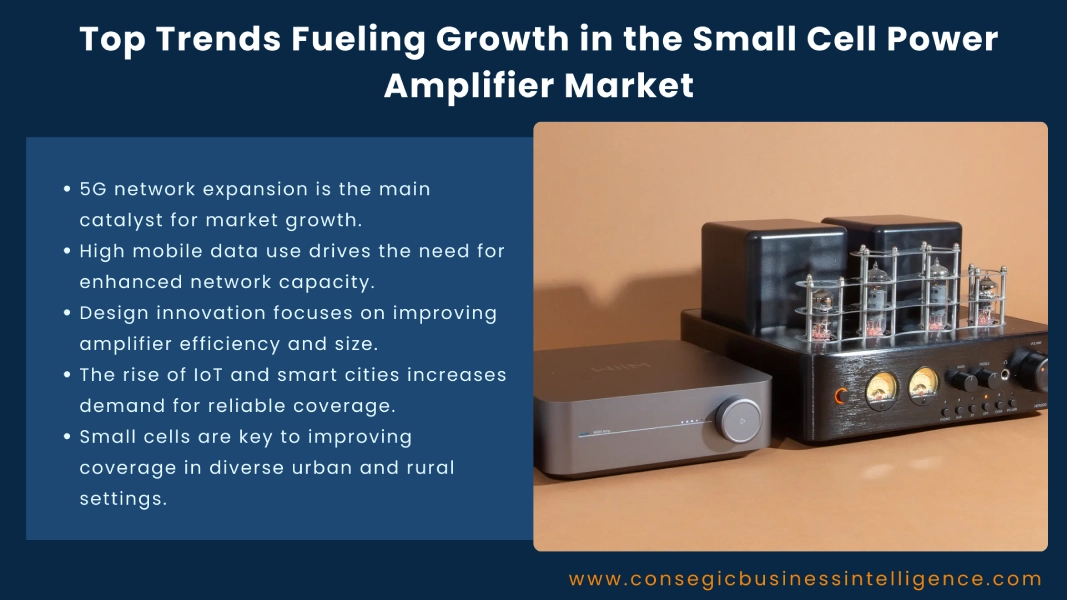Top Trends Fueling Growth in the Small Cell Power Amplifier Market
Small cell power amplifiers play a critical role in boosting signal strength for small cell base stations, enabling high-quality mobile connectivity in both urban and rural environments. With the rapid expansion of 4G and 5G networks, the demand for these amplifiers has grown significantly. They ensure efficient power transmission, improve coverage, and enhance the overall network capacity for telecom operators. As mobile data consumption continues to rise, network providers are deploying more small cells to manage high traffic and maintain service quality. This is driving innovation in small cell power amplifier designs, efficiency, and integration.

Below are the top trends that are fueling the growth of the small cell Power Amplifier Market.
- Expansion of 5G Network Deployments
The global rollout of 5G networks is one of the biggest drivers of small cell power amplifier demand. 5G requires a dense network of small cells to deliver low-latency, high-speed connections. Furthermore, power amplifiers optimized for 5G frequencies, including sub-6 GHz and mmWave bands, are increasingly in demand. Moreover, manufacturers are focusing on designs that can handle wide bandwidths and support massive MIMO configurations.
- Growing Adoption of mmWave Technology
Millimeter wave (mmWave) technology is becoming essential for delivering ultra-fast 5G speeds. However, mmWave signals have limited range, making small cells and their power amplifiers crucial for coverage. The need for high-frequency, high-efficiency amplifiers that can operate in dense urban environments is pushing R&D toward compact, thermally efficient designs. This trend is especially prominent in countries prioritizing high-band 5G services.
- Shift Toward Energy-Efficient Designs
Energy efficiency is a major priority for telecom operators seeking to lower operating costs and meet sustainability targets. Modern small cell power amplifiers are being engineered to deliver higher output power with lower energy consumption. Further, innovations in GaN (Gallium Nitride) and LDMOS (Laterally Diffused Metal Oxide Semiconductor) technologies are improving efficiency while maintaining performance, allowing operators to deploy greener networks.
- Integration with Massive MIMO and Beamforming
Massive MIMO (Multiple Input, Multiple Output) and beamforming are essential for boosting network capacity and coverage in 5G systems. Small cell power amplifiers now need to work seamlessly with these technologies, offering precise signal amplification across multiple antennas. This integration requires advanced amplifier designs that maintain linearity and minimize distortion, ensuring optimal performance in complex network environments.
- Increased Demand in Indoor Coverage Solutions
With more people relying on mobile connectivity indoors for work, entertainment, and communication the demand for small cells and power amplifiers in indoor environments is rising. Shopping malls, stadiums, airports, and office complexes are deploying small cell networks to enhance coverage. Power amplifiers designed for indoor small cells prioritize compact size, low noise, and minimal heat generation to ensure reliable operation in enclosed spaces.
- Advances in Semiconductor Materials
The choice of semiconductor material has a direct impact on amplifier performance. Gallium Nitride (GaN) and Silicon Germanium (SiGe) are gaining popularity due to their ability to handle higher power levels, improve thermal performance, and operate efficiently at higher frequencies. These advancements are allowing manufacturers to create amplifiers that meet the demanding requirements of next-generation telecom networks while reducing footprint and cost.
- Growing Use in Private and Enterprise 5G Networks
Enterprises in manufacturing, logistics, healthcare, and education are increasingly adopting private 5G networks to improve operational efficiency and security. Small cell power amplifiers are a key component in these setups, ensuring strong and reliable coverage across facilities. This growing enterprise adoption is opening new revenue streams for amplifier manufacturers and encouraging the development of flexible, application-specific designs.
- Rising Investments in Smart Cities and IoT Connectivity
Smart city projects and the expansion of the Internet of Things (IoT) are driving the deployment of dense, low-latency networks. Small cells equipped with advanced power amplifiers are essential to support the massive number of connected devices in these environments. Whether enabling real-time traffic management or supporting connected public safety systems, these amplifiers are becoming an integral part of modern urban infrastructure.
Conclusion
The small cell power amplifier market is experiencing strong growth, driven by the expansion of 5G, the adoption of mmWave technology, and the push for energy efficiency. Trends like integration with massive MIMO, improved indoor coverage, and the use of advanced semiconductor materials are reshaping product design and capabilities. Additionally, the rise of private 5G networks and smart city initiatives is opening new opportunities for manufacturers and solution providers.
As telecom operators and enterprises continue to invest in high-performance, energy-efficient network infrastructure, small cell power amplifiers will remain a vital component in meeting the growing demand for fast, reliable, and seamless connectivity. Companies that can innovate in efficiency, size, and integration will be best positioned to lead this evolving market in 2025 and beyond.
